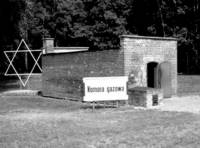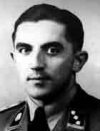 |
| Gas Chamber |
Stutthof (Sztutowo) is the name of a small village situated 36 km (22 miles) from
Gdansk (Danzig) and 3 km from the Baltic coast. A “camp
for civilian war prisoners” (
Zivilgefangenenlager) was established there on
2 September 1939.
Initially subordinated to the local authorities of the
Gdansk – West Prussia Region, in
November 1941,
it became a "labour education" camp, administered by the German Security Police.
Finally, on
7 January 1942, it officially became a concentration camp under the
control of the Inspectorate of Concentration Camps.
The precise date when construction of the gas chamber at Stutthof began is uncertain. The chamber,
5 m long, 3 m wide and 2.5 m high, was originally built as a room for delousing clothing, a purpose
for which it continued to be utilised even when functioning as a gas chamber for the murder of human
beings. As at
Auschwitz-Birkenau, the killing agent used was "Zyklon B",
which was introduced via a small opening in the ceiling. The chamber was heated before each operation
to hasten the release of the hydrocyanic acid. The gassings were supervised by
SS-Unterscharführer Otto Karl Knott,
who had been trained in the use of "Zyklon B" at
KZ Oranienburg
in the
summer 1943. During the course of a visit to Stutthof,
SS-Obersturmbannführer Rudolf Höss,
the former commandant of
KZ Auschwitz, gave detailed
instructions on the gassing procedure to be followed.
 |
| Hoppe |
The first known gassing at Stutthof occurred on
22 June 1944, when about 100 persons,
mainly Poles and Byelorussians were killed. On
26 July 1944, 12 members of a
Polish resistance group were gassed, to be followed by approximately 70 invalids transferred from
a Soviet POW camp. The camp commandant,
SS-Hauptsturmführer Paul Werner Hoppe
then received orders to kill the Jewish inmates of the camp.
Between
August and November 1944 more than 1,450 victims, most of them Jewish
women, are known to have been gassed. Some gassings took place in a
railway car on a siding
leading to the camp. The openings in the gassing car had been hermetically sealed. "Zyklon B" was
introduced via an opening in the roof of the car.
Gassing operations at Stutthof ceased in
early November 1944. It has been estimated that at least
65,000 inmates died in the camp during its existence. The total number murdered in the gas chamber
has not been determined. Today (2005) the gas chamber buildings is still on view.
Trial:
Case Nr.446
Crime Category: Mass Extermination Crimes in Camps
Accused: Hoppe, Paul-Werner 9 Years;
Knott, Otto-Karl 3 Years 3 Months
Court: LG
Bochum 570604, LG
Bochum 551216, BGH 561108
Country where the crime was committed: Poland
Crime Location: HS KL Stutthof
Crime Date: 42-44
Victims: Jews
Nationality: unknown
Office: Haftstättenpersonal KL Stutthof
Subject of the proceeding: Gassing of hundreds of Jewish prisoners in the clothings' delousing barracks
of the concentration camp and in a railway wagon posted close to the crematorium. Killings by
shootings in the back of the neck in a room adjacent to the crematorium. Killing of at least 50 ill
prisoners of KL Stutthof by means of petrol injections, partly within the context of the 'Aktion 14f13'.
Killing of at least 10 prisoners, who were tracked down during escape attempts, by the dogs' brigade, and were fatally bitten.
Sources:
Gutman, Israel ed.
Encyclopedia of the Holocaust. Macmillan Publishing Company, New York, 1990
Kogon, Eugen; Langbein, Hermann; Rückerl, Adalbert; eds.
Nazi Mass Murder, Yale University
Press, New Haven and London, 1993
Orski, Marek.
The Last Days of Stutthof, Muzeum Stutthof w Sztutowie, 1998
© ARC 2005









